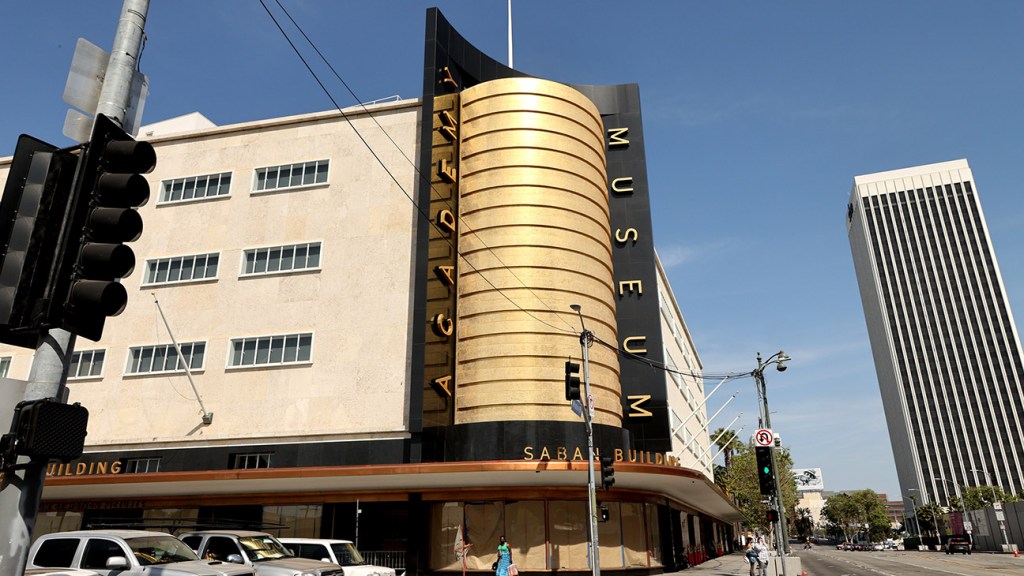
When the Academy Museum of Motion Pictures opened in 2021, many Academy members and cultural critics were shocked and outraged to discover that one of the few marginalized groups whose contributions to Hollywood were not highlighted within its walls were Jews, especially because most of the founders of the business were Jewish.
The leaders of the Academy and its museum heard the feedback loud and clear, and announced on Thursday that they will debut the museum’s first permanent exhibition, Hollywoodland: Jewish Founders and the Making of a Movie Capital, in its LAIKA Gallery, on May 19.
The exhibition, which “tells the origin story of filmmaking in early 20th-century Los Angeles, spotlighting the impact of the predominately Jewish filmmakers whose establishment of the American film studio system transformed Los Angeles into a global epicenter of cinema,” was put together by Dara Jaffe, associate curator, with support from Gary Dauphin, former associate curator of digital presentations, and Josue L. Lopez, research assistant. Serving as an advisor for the exhibition was esteemed film historian and author Neal Gabler, who literally wrote the book on Jews in Hollywood, 1989’s An Empire of Their Own: How the Jews Invented Hollywood (which, last October, was chosen by a blue-ribbon panel organized by THR as the sixth greatest film book of all-time).
“The American film industry began developing amid an influx of immigration to the United States by Jewish émigrés escaping European pogroms and poverty,” Jaffe said in a statement. “Most of Hollywood’s founders were among this wave of Jewish immigrants and recognized that the infant movie business presented an opportunity to raise their marginalized status in an industry that didn’t enforce the same antisemitic barriers as many other professions. Hollywoodland also posits the question: how and why did Los Angeles bloom into a world-renowned cinema capital? The goal of our exhibition is to show the inextricable dovetailing of these histories.”
“We are so proud to bring this foundational story of American filmmaking to the museum as a permanent exhibition,” added Academy Museum director and president Jacqueline Stewart. “The stories told in Hollywoodland bring the intertwined histories of Los Angeles and the Hollywood studio system to life and resonate with stories of immigrants from around the world.”
The exhibition’s opening day will feature two special programs open to the public: Gabler will sign copies of his aforementioned tome in the Ted Mann Theater Lobby from 4:30-5:30pm, and then at 6pm will head inside the Ted Mann Theater to participate in a conversation with Jaffe moderated by Stewart.
Below are further details of the exhibition provided by the Academy Museum.
EXHIBITION DETAILS
Located in the museum’s LAIKA Gallery, Hollywoodland is an immersive exhibition chronicling the studio system’s evolution during the early 20th century. It details how the American movie industry — built predominately by Jewish immigrants — transformed Los Angeles into the mythological concept of “Hollywood” that prevails today, as well as the complex legacy that the studio system leaves behind. The exhibition is elaborated in three distinct parts: Studio Origins, an exploration of the founding of Hollywood’s original eight “major” film studios (often referred to as “the majors”) and their respective studio heads; Los Angeles: From Film Frontier to Industry Town, 1902–1929, an immersive projection experience where visitors trace the evolving landscape of Los Angeles alongside the advancement of the movie industry; and From the Shtetl to the Studio: The Jewish Story of Hollywood, a short form documentary, narrated by TCM host and author Ben Mankiewicz, that illustrates the experiences of the Jewish immigrants and first-generation Jewish Americans who were primarily responsible for building the Hollywood studio system. The exhibition is designed for visitors to enter and exit through the same door so that they can experience these three sections in any order.
Studio Origins explores the establishment of the studio system and “the majors”—Universal, Fox (later Twentieth Century-Fox), Paramount, United Artists, Warner Bros., Columbia, Metro-Goldwyn-Mayer, and RKO—and the studio heads that shaped them. Visitors will learn about each studio’s origin story through dedicated multimedia displays highlighting significant milestones, movies, filmmakers, locations, and gain a deeper understanding of how the studio system transformed the American film industry.
Los Angeles: From Film Frontier to Industry Town, 1902–1929 illustrates how the landscape of Los Angeles developed alongside the newly established and quickly expanding film industry, redefining the city itself. Consisting of an animated tabletop map of Los Angeles and choregraphed projection screen, this section of the exhibition features a timeline structured around a series of chronologically revealed locations relevant to the city’s early film industry, such as filming locations, studio locations, and cultural landmarks. It will also address lesser-known stories of independent producers active in early 1900s Los Angeles. While 1902–1929 is the focused timeline, the experience will quickly “rewind” and “fast-forward” in and out of the present day to connect and ground visitors in a current, more familiar version of Los Angeles. The map encourages visitors to further explore this history through the Academy Museum’s digital Hollywood Past and Present experience.
From the Shtetl to the Studio: The Jewish Story of Hollywood is an original short-form documentary that delves into the nuances of Hollywood’s Jewish history, exploring how the shared backgrounds of the industry founders weave together a complex immigrant story characterized by both oppression and innovation. Narrated by Ben Mankiewicz, the documentary features archival imagery and film clips, illustrating the larger global context at the turn of the 20th century as well as personal narratives of the predominantly Jewish founders of the Hollywood studio system. The film examines how antisemitism shaped the founders’ trajectories throughout their careers and how their projected vision of an immigrant’s American Dream came to define America itself on movie screens around the world.
Read More: World News | Entertainment News | Celeb News
Hollywood







